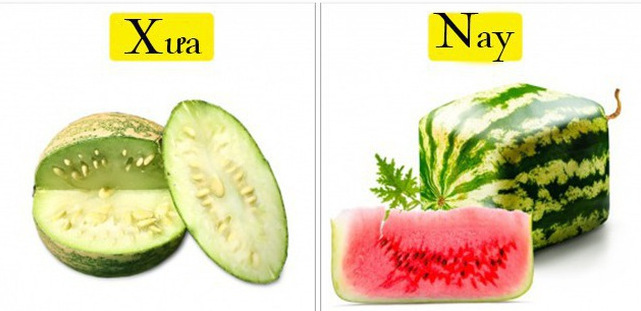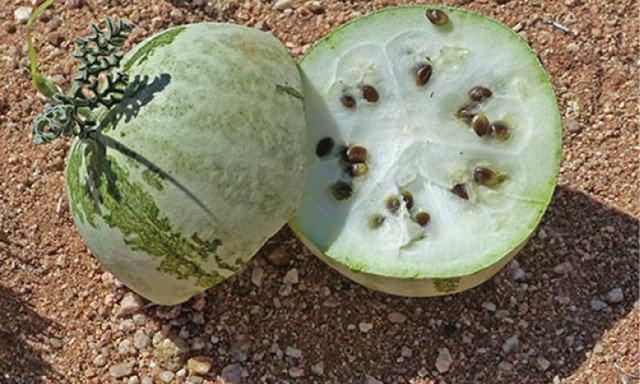You are curious, how the ancestors of today's vegetables are shaped
Most of the food we use every day has been tamed by humans since the past year. With breeding techniques, we have created crops that are far from their ancestors. So, before being domesticated, what kind of fruits do we still eat every day? Let's find out!
- 18 tips to help preserve vegetables for a long time
- 10 types of "bathing" vegetables and fruits are the most pesticides
1. Watermelon

Thousands of years ago, the ancestors of watermelons had white intestines, light green, hard, spongy, with partitions and bitterness. After many breeding selections, especially thanks to the red gene grafted with genes that determine the amount of sugar, watermelon has turned into red and more flesh.

The ancestral melon species has a diameter of only about 50mm but now it has increased to 660mm.
2. Bananas

Formerly, bananas have lots of hard seeds. Currently, bananas have much smaller, delicious, nutritious seeds that can be peeled and are easy to handle by hand.
3. Carrots

The carrots that we still eat today have small roots, orange bodies, edible and a strong smell. But its ancestors are very different, wild carrots are white or purple, hard, have many small and bitter roots.
4. Eggplant

The ancestors of today's eggplant are a wild fruit variety of different colors ranging from ivory, blue, purple to yellow and thorny in flower stalks. They usually grow along the sides of the road, some of the original eggplant fruit is round.
Through the breeding process, the stems in the stalks have been removed, the fruits are long, purple and have the size as large as now.
5. Ngo

The ancestor of the corn called Teosinte, was first planted around 7000 BC. At that time, corn has a very different shape from now, about 2.5cm long, very hard and almost inedible. People have to use crushed stone many times to make the corn grain break and get the soft flesh inside.
After being domesticated by Europeans, new corn has the shape and taste that it is today. Initially corn was only a classic yellow color but now there are many sparkling corn varieties.
6. Tomato

The original tomato is a small, purple, purple fruit tree. Compared to their ancestors, tomatoes today have a big change in color and size. But whatever the time, tomatoes are still a good source of vitamin C and vitamin A.
7. Strawberry

Wild strawberries are small but in return they are delicious with a very delicate scent. Today's strawberries, though larger in size, still retain their distinctive aroma but have lost their wonderful taste like their ancestors.
8. Potatoes

Wild potatoes originated in southern Peru and extreme northwestern Bolivia today. In ancient times, potatoes were purple, yellow, small and had a distorted shape. After being domesticated, today's potatoes have a well-rounded, yellow-brown shell that looks good.
You should read it
- Miraculous healing ability of spinach, vegetables are often present on the family's tray
- Great reasons you should eat vegetables daily
- Warning signs of your body eating too little vegetables
- List of good fruits and vegetables for gout patients
- Good fruits and vegetables for men, encouraged by experts
- 18 tips to help preserve vegetables for a long time
- Wind chimes can encourage children to eat more green vegetables
- Soak vegetables in salt water to eliminate harmful chemicals, mistakes need to change
May be interested
- The rare giant 'living fossil' salamander stuck two years in the sewer line
 a rare and precious giant salamander belonging to a group of extremely endangered animals is found trapped inside a sewer at a resident's home in wuhan, china. most likely the salamander has been in it for two years.
a rare and precious giant salamander belonging to a group of extremely endangered animals is found trapped inside a sewer at a resident's home in wuhan, china. most likely the salamander has been in it for two years. - Dinosaurs have used colors to camouflage
 a small dinosaur has used colors to camouflage, hide and confuse enemies, a new study says.
a small dinosaur has used colors to camouflage, hide and confuse enemies, a new study says. - Watch the 'circus' aquarium dance with your eyes jumping over the water
 under the master's command, the aquarium fish swings up and leaps out of the water and 'flies' through the small ring high above. the video recorded the scene of the siamese fish 'circus' which made many people unable to keep up.
under the master's command, the aquarium fish swings up and leaps out of the water and 'flies' through the small ring high above. the video recorded the scene of the siamese fish 'circus' which made many people unable to keep up. - The python vomit is 1.5 meters long when rescued
 after bringing the python out of the people's home in samut songkram, thailand, the lifeguards were amazed to see it vomit a 1.5m long daemon.
after bringing the python out of the people's home in samut songkram, thailand, the lifeguards were amazed to see it vomit a 1.5m long daemon. - Scientists successfully replicated the world's first cloned dog
 3 puppies are replicated from the world's first cloned dog, which is 9 months old and still healthy.
3 puppies are replicated from the world's first cloned dog, which is 9 months old and still healthy. - Close up of the Agung volcano in Bali erupts 4000m smoke pillars into the air
 the gray sky rising from the ash from agung crater in bali, indonesia was recorded by michael flynn, an australian photographer.
the gray sky rising from the ash from agung crater in bali, indonesia was recorded by michael flynn, an australian photographer.






 Do not confuse the vegetables as weeds, you will be shocked to know its miraculous use!
Do not confuse the vegetables as weeds, you will be shocked to know its miraculous use! Miraculous healing ability of spinach, vegetables are often present on the family's tray
Miraculous healing ability of spinach, vegetables are often present on the family's tray 10 most pesticide-free vegetables and fruits
10 most pesticide-free vegetables and fruits Marvel at the 10 most bizarre shaped flowers in the world
Marvel at the 10 most bizarre shaped flowers in the world Great reasons you should eat vegetables daily
Great reasons you should eat vegetables daily